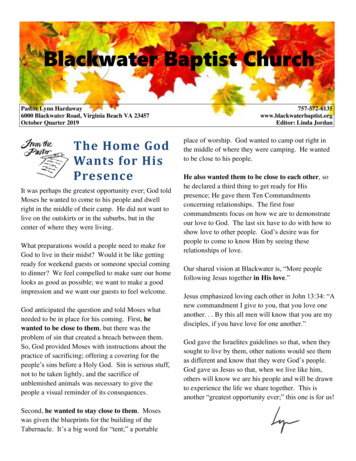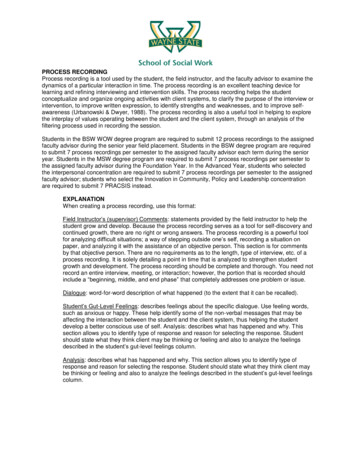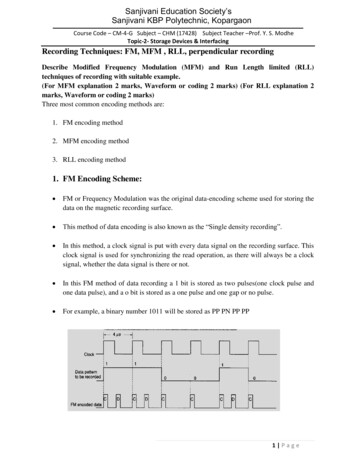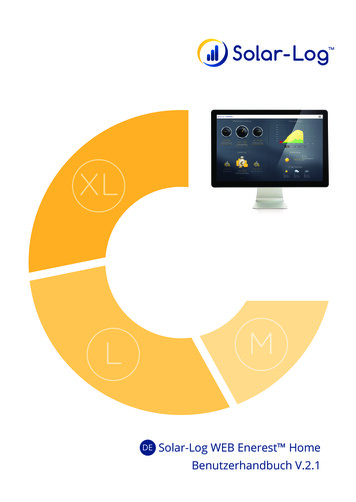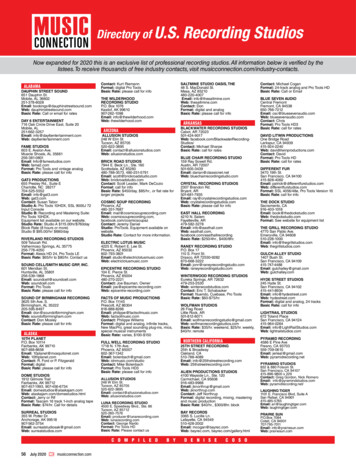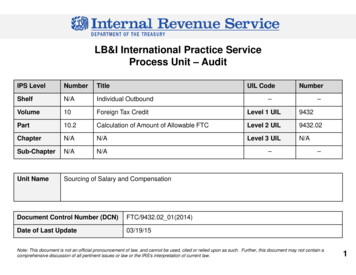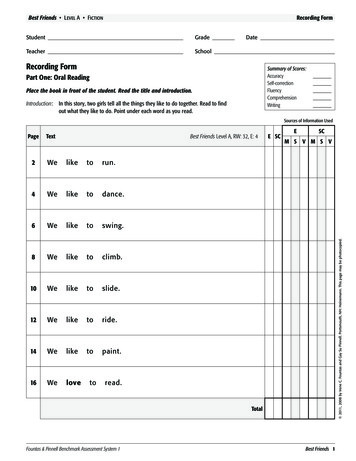
Transcription
Best Friends Level A FictionRecording FormStudentGradeDateTeacherSchoolRecording FormSummary of WritingPart One: Oral ReadingPlace the book in front of the student. Read the title and introduction.Introduction:In this story, two girls tell all the things they like to do together. Read to findout what they like to do. Point under each word as you read.Sources of Information eliketopaint.16WelovetoE SCESCM S V M S V 2011, 2008 by Irene C. Fountas and Gay Su Pinnell. Portsmouth, NH: Heinemann. This page may be photocopied.Best Friends Level A, RW: 32, E: 4Pageread.TotalFountas & Pinnell Benchmark Assessment System 1Best Friends 1
Best Friends Level A FictionRecording Form4 orAcAccuracyRateErrors %(E SC) SC 1: 2011, 2008 by Irene C. Fountas and Gay Su Pinnell. Portsmouth, NH: Heinemann. This page may be photocopied.2 Best FriendsFountas & Pinnell Benchmark Assessment System 1
Best Friends Level A FictionRecording FormPart Two: Comprehension ConversationComprehension Scoring KeyHave a conversation with the student, noting the key understandingsthe student expresses. Use prompts as needed to stimulate discussion ofunderstandings the student does not express. It is not necessary to useevery prompt for each book. Score for evidence of all understandingsexpressed—with or without a prompt. Circle the number in the scorecolumn that reflects the level of understanding demonstrated.Teacher:0Reflects unsatisfactory understanding of the text. Either does notrespond or talks off the topic.1Reflects limited understanding of the text. Mentions a few facts orideas but does not express the important information or ideas.2Reflects satisfactory understanding of the text. Includes importantinformation and ideas but neglects other key understandings.3Reflects excellent understanding of the text. Includes almost allimportant information and main ideas.Talk about what happened in this story.Key UnderstandingsPromptsScoreWithin the TextThere are lots of different things the girls like to do together.(Gives 2–3 examples such as run, dance, swing, climb, slide,ride, paint, and read.)Note any additional understandings:Tell some things the girls like to do together.01230123Can you tell more things they like to dotogether?The girls like to do things with each other.How can you tell these girls are best friends?The girls like to read more than they like to do other things.Of all the things the girls do together,what’s their favorite thing to do? Why?The author made the the word love darker to show they likedreading best.The author told about all the things the girlsliked to do. Look at the last page. Why didthe author make the word love very dark?The author said love instead of like to show they liked readingbest.Note any additional understandings:Subtotal Score:/6Add 1 for any additional understandings:/1Total Score:/7Guide to Total Score6–7 Excellent Comprehension5Satisfactory Comprehension4Limited Comprehension0–3 Unsatisfactory ComprehensionPart Three: Writing About Reading (optional)Read the writing/drawing prompt on the next page to the student. Specify the amountof time for the student to complete the task. (See Assessment Guide for moreinformation.)Writing About Reading Scoring Key0 Reflects no understanding of the text.1 Reflects very limited understanding of the text.2 Reflects partial understanding of the text.3 Reflects excellent understanding of the text.Fountas & Pinnell Benchmark Assessment System 1Best Friends 3 2011, 2008 by Irene C. Fountas and Gay Su Pinnell. Portsmouth, NH: Heinemann. This page may be photocopied.Beyond and About the Text
Recording FormStudentBest Friends Level A FictionDateWrite about what the two girls like to do together. You can drawa picture to go with your writing. 2011, 2008 by Irene C. Fountas and Gay Su Pinnell. Portsmouth, NH: Heinemann. This page may be photocopied.4 Best FriendsFountas & Pinnell Benchmark Assessment System 1
At the Park Level A NonfictionRecording FormStudentGradeDateTeacherSchoolRecording FormSummary of WritingPart One: Oral ReadingPlace the book in front of the student. Read the title and introduction.Introduction:This boy is telling all the things he can do at the park with his dad. Read to findout what he says he can do. Point under each word as you read.Sources of Information UsedTextAt the Park Level A, RW: 24, E: 3 E wing.12Icanslide.14Icanrun.16Icanhide.ESCM S V M S V 2011, 2008 by Irene C. Fountas and Gay Su Pinnell. Portsmouth, NH: Heinemann. This page may be photocopied.PageTotalFountas & Pinnell Benchmark Assessment System 1At the Park 1
At the Park Level A NonfictionRecording Form3 orAcAccuracyRateErrors more%SSelf-CorrectionRatioBelow90%21092%96%100%(E SC) SC 1: 2011, 2008 by Irene C. Fountas and Gay Su Pinnell. Portsmouth, NH: Heinemann. This page may be photocopied.2 At the ParkFountas & Pinnell Benchmark Assessment System 1
At the Park Level A NonfictionRecording FormPart Two: Comprehension ConversationComprehension Scoring KeyHave a conversation with the student, noting the key understandingsthe student expresses. Use prompts as needed to stimulate discussion ofunderstandings the student does not express. It is not necessary to useevery prompt for each book. Score for evidence of all understandingsexpressed—with or without a prompt. Circle the number in the scorecolumn that reflects the level of understanding demonstrated.Teacher:0Reflects unsatisfactory understanding of the text. Either does notrespond or talks off the topic.1Reflects limited understanding of the text. Mentions a few facts orideas but does not express the important information or ideas.2Reflects satisfactory understanding of the text. Includes importantinformation and ideas but neglects other key understandings.3Reflects excellent understanding of the text. Includes almost allimportant information and main ideas.Talk about what you learned in this book.Key UnderstandingsPromptsScoreWithin the TextTalk about what things the boy can doat the park.0123It’s fun to (gives opinion or examples from own life)at the park.What are some fun things to do at the park?0123Some other things they could do at the park are(gives examples).Can you think of some other things thatthe boy and his dad could do at the park?Some people like to go to the park because they can(be outside and play, have picnics, etc).Why do people like to go to the park?The boy really likes to go to the park with his dad because(gives any reasonable explanation).Why do you think the boy likes to go tothe park?The boy and his dad are smiling.Look at pages 14 and 15. How does thepicture help you know the boy and his dadlike to go to the park?The boy can do lots of things at the park. (Gives 2–3 examplessuch as ride, kick, catch, jump, swing, slide, run, and hide.)Note any additional understandings:Note any additional understandings:Subtotal Score:/6Add 1 for any additional understandings:/1Total Score:/7Guide to Total Score6–7 Excellent Comprehension5Satisfactory Comprehension4Limited Comprehension0–3 Unsatisfactory ComprehensionPart Three: Writing About Reading (optional)Read the writing/drawing prompt on the next page to the student. Specify the amountof time for the student to complete the task. (See Assessment Guide for moreinformation.)Writing About Reading Scoring Key0 Reflects no understanding of the text.1 Reflects very limited understanding of the text.2 Reflects partial understanding of the text.3 Reflects excellent understanding of the text.Fountas & Pinnell Benchmark Assessment System 1At the Park 3 2011, 2008 by Irene C. Fountas and Gay Su Pinnell. Portsmouth, NH: Heinemann. This page may be photocopied.Beyond and About the Text
Recording FormStudentAt the Park Level A NonfictionDateWrite about what the boy can do at the park. You can draw apicture to go with your writing. 2011, 2008 by Irene C. Fountas and Gay Su Pinnell. Portsmouth, NH: Heinemann. This page may be photocopied.4 At the ParkFountas & Pinnell Benchmark Assessment System 1
My Little Dog Level B FictionRecording FormStudentGradeDateTeacherSchoolRecording FormSummary of WritingPart One: Oral ReadingPlace the book in front of the student. Read the title and introduction.Introduction:This girl has a little dog. Read to find out all the things her little dog likesto do with her. Point under each word as you read.Sources of Information UsedPage sto6Myto8HetoeatlittlerunwithdogwithESCM S V M S Vme. 2011, 2008 by Irene C. Fountas and Gay Su Pinnell. Portsmouth, NH: Heinemann. This page may be photocopied.2My Little Dog Level B, RW: 55, E: 6 E SClikesme.likesplaywithme.SubtotalFountas & Pinnell Benchmark Assessment System 1My Little Dog 1
My Little Dog Level B FictionRecording FormPart One: Oral Reading continuedSources of Information UsedPage Text10Heto1214ridewithtojumpwithme.littledoglikes 2011, 2008 by Irene C. Fountas and Gay Su Pinnell. Portsmouth, NH: Heinemann. This page may be photocopied.MySCM S V M S Vme.likesMyElikesHeto16E SCreadlittlewithdogme.likesme!SubtotalTotal2 My Little DogFountas & Pinnell Benchmark Assessment System 1
My Little Dog Level B Fiction6 orAcAccuracyRateErrors more%54321091%93%95%96%98%100%(E SC) SC 1: 2011, 2008 by Irene C. Fountas and Gay Su Pinnell. Portsmouth, NH: Heinemann. This page may be photocopied.SSelf-CorrectionRatioBelow90%Recording FormFountas & Pinnell Benchmark Assessment System 1My Little Dog 3
My Little Dog Level B FictionRecording FormPart Two: Comprehension ConversationComprehension Scoring KeyHave a conversation with the student, noting the key understandingsthe student expresses. Use prompts as needed to stimulate discussion ofunderstandings the student does not express. It is not necessary to useevery prompt for each book. Score for evidence of all understandingsexpressed—with or without a prompt. Circle the number in the scorecolumn that reflects the level of understanding demonstrated.Teacher:0Reflects unsatisfactory understanding of the text. Either does notrespond or talks off the topic.1Reflects limited understanding of the text. Mentions a few facts orideas but does not express the important information or ideas.2Reflects satisfactory understanding of the text. Includes importantinformation and ideas but neglects other key understandings.3Reflects excellent understanding of the text. Includes almost allimportant information and main ideas.Talk about what happened in this story.Key UnderstandingsPromptsScoreWithin the TextThe girl is telling about her little dog and the things he can do.What did the girl tell about in the book?The little dog likes to do lots of things with her. (Gives 2–3examples such as sleep, eat, run, play, ride, jump, and read.)Tell some of the things this little dog likesto do with the girl.01230123Note any additional understandings:Beyond and About the Text 2011, 2008 by Irene C. Fountas and Gay Su Pinnell. Portsmouth, NH: Heinemann. This page may be photocopied.The little dog likes to do lots of things and probably likes to doother things too (gives examples).What other things do you think the littledog likes to do with the girl?The girl is really proud of (or loves) her dog.How do you think the girl feels about herlittle dog?This dog is like my dog (or makes any personal connection).Did this book remind you of anything?The pictures show that they like each other because (anyreasons based on any picture; for example, on page 16 she issmiling and petting the dog and the dog is licking her).Look at page 16. How does the pictureshow you that the little girl and the dog likeeach other?Note any additional understandings:Subtotal Score:/6Add 1 for any additional understandings:/1Total Score:/7Guide to Total Score6–7 Excellent Comprehension5Satisfactory Comprehension4Limited Comprehension0–3 Unsatisfactory ComprehensionPart Three: Writing About Reading (optional)Read the writing/drawing prompt on the next page to the student. Specify the amountof time for the student to complete the task. (See Assessment Guide for moreinformation.)Writing About Reading Scoring Key0 Reflects no understanding of the text.1 Reflects very limited understanding of the text.2 Reflects partial understanding of the text.3 Reflects excellent understanding of the text.4 My Little DogFountas & Pinnell Benchmark Assessment System 1
My Little Dog Level B FictionStudentRecording FormDateWrite about three things the little dog likes to do. You can draw 2011, 2008 by Irene C. Fountas and Gay Su Pinnell. Portsmouth, NH: Heinemann. This page may be photocopied.a picture to go with your writing.Fountas & Pinnell Benchmark Assessment System 1My Little Dog 5
Playing Level B NonfictionRecording FormStudentGradeDateTeacherSchoolRecording FormSummary of WritingPart One: Oral ReadingPlace the book in front of the student. Read the title and introduction.In this book, a girl is playing with lots of different things. Read about all thethings she likes to play with. Point under each word as you read.Introduction:Sources of Information UsedPage Text2IPlaying Level B, RW: 56, E: 6 E SClikewith4I 2011, 2008 by Irene C. Fountas and Gay Su Pinnell. Portsmouth, NH: Heinemann. This page may be photocopied.Ilikewith8Ialikewith6tolikewithESCM S V M S ubtotal1 PlayingFountas & Pinnell Benchmark Assessment System 1
Playing Level B NonfictionRecording FormPart One: Oral Reading continuedSources of Information UsedPage TextIlikewith12IIIlikewithSCM S V M S layplayboat.tomy 2011, 2008 by Irene C. Fountas and Gay Su Pinnell. Portsmouth, NH: Heinemann. This page may be photocopied.10E SCplaydog!SubtotalTotalFountas & Pinnell Benchmark Assessment System 1Playing 2
Playing Level B NonfictionRecording Form6 orAcAccuracyRateErrors 6%98%100%(E SC) SC 1: 2011, 2008 by Irene C. Fountas and Gay Su Pinnell. Portsmouth, NH: Heinemann. This page may be photocopied.3 PlayingFountas & Pinnell Benchmark Assessment System 1
Playing Level B NonfictionRecording FormPart Two: Comprehension ConversationComprehension Scoring KeyHave a conversation with the student, noting the key understandingsthe student expresses. Use prompts as needed to stimulate discussion ofunderstandings the student does not express. It is not necessary to useevery prompt for each book. Score for evidence of all understandingsexpressed—with or without a prompt. Circle the number in the scorecolumn that reflects the level of understanding demonstrated.Teacher:0Reflects unsatisfactory understanding of the text. Either does notrespond or talks off the topic.1Reflects limited understanding of the text. Mentions a few facts orideas but does not express the important information or ideas.2Reflects satisfactory understanding of the text. Includes importantinformation and ideas but neglects other key understandings.3Reflects excellent understanding of the text. Includes almost allimportant information and main ideas.Talk about what you learned in this book.Key UnderstandingsPromptsScoreWithin the TextTell some of the things the girl likes to playwith.The girl likes to play with lots of different things.(Gives 3–4 examples such as truck, car, ball, doll,train, plane, boat, and dog.)01230123What else can you say about what the girllikes to do?Note any additional understandings:Some of the things the girl likes to play with are toys,but a dog is not a toy.What do you notice about the things thegirl likes to play with?I like (or have) some of the same things the girl likesto play with.Does this book make you think of thingsyou like to play with?The girl is having fun in this story.How do you think the girl was feeling inthis story?The last thing she plays with is the dog because everything elseis a toy, but the dog is alive and can play with her.The girl played with the dog last. How is thedog different from all the other things?Note any additional understandings:Subtotal Score:/6Add 1 for any additional understandings:/1Total Score:/7Guide to Total Score6–7 Excellent Comprehension5Satisfactory Comprehension4Limited Comprehension0–3 Unsatisfactory ComprehensionPart Three: Writing About Reading (optional)Read the writing/drawing prompt on the next page to the student. Specify the amountof time for the student to complete the task. (See Assessment Guide for moreinformation.)Writing About Reading Scoring Key0 Reflects no understanding of the text.1 Reflects very limited understanding of the text.2 Reflects partial understanding of the text.3 Reflects excellent understanding of the text.Fountas & Pinnell Benchmark Assessment System 1Playing 4 2011, 2008 by Irene C. Fountas and Gay Su Pinnell. Portsmouth, NH: Heinemann. This page may be photocopied.Beyond and About the Text
Recording FormStudentPlaying Level B NonfictionDateWrite about three things the girl likes to play with. You can drawa picture to go with your writing. 2011, 2008 by Irene C. Fountas and Gay Su Pinnell. Portsmouth, NH: Heinemann. This page may be photocopied.5 PlayingFountas & Pinnell Benchmark Assessment System 1
Socks Level C FictionRecording FormStudentGradeDateTeacherSchoolRecording FormSummary of WritingPart One: Oral ReadingPlace the book in front of the student. Read the title and introduction.Socks the cat was sleeping in lots of different places, and the girl wanted herto wake up. Read to find out what makes Socks wake up.Introduction:Sources of Information UsedSocks Level C, RW: 79, E: 9 E SCPage TextSocksonwasthe“WakeI4onup,Socks! e6M S V M S Vsaid.SocksISC 2011, 2008 by Irene C. Fountas and Gay Su Pinnell. Portsmouth, NH: Heinemann. This page may be photocopied.2Eup,wastheSocks! ”sleepingcouch.SubtotalFountas & Pinnell Benchmark Assessment System 1Socks 1
Socks Level C FictionRecording FormPart One: Oral Reading continuedSources of Information UsedPage Text6E SC“Wakeup,ESCM S V M S VSocks! ”cont.I8said.ShewasonIthe 2011, 2008 by Irene C. Fountas and Gay Su Pinnell. Portsmouth, NH: Heinemann. This page may be asthesaid,sleepingwindow.“Socks,wakeup! ”SockswasbytheSocks! ”sleepingdoor.Subtotal2 SocksFountas & Pinnell Benchmark Assessment System 1
Socks Level C FictionRecording FormPart One: Oral Reading continuedSources of Information UsedPage Text12E SC“WakeESCM S V M S Vup! IcanIsaid.wakeSocksup,” 2011, 2008 by Irene C. Fountas and Gay Su Pinnell. Portsmouth, NH: Heinemann. This page may be photocopied.IPurrSubtotalTotalFountas & Pinnell Benchmark Assessment System 1Socks 3
Socks Level C FictionRecording Form9AcAccuracyRateErrors or more%Below90%SSelf-CorrectionRatioFluency Score87654321090%91%92%94%95%96%97%99%100%(E SC) SC 1:0123Fluency Scoring Key0Reads primarily word-by-word with occasional but infrequent or inappropriate phrasing;no smooth or expressive interpretation, irregular pausing, and no attention to author’smeaning or punctuation; no stress or inappropriate stress, and slow rate.1Reads primarily in two-word phrases with some three- and four-word groups and someword-by-word reading; almost no smooth, expressive interpretation or pausing guidedby author’s meaning and punctuation; almost no stress or inappropriate stress, with slowrate most of the time.2Reads primarily in three- or four-word phrase groups; some smooth, expressiveinterpretation and pausing guided by author’s meaning and punctuation; mostlyappropriate stress and rate with some slowdowns.3Reads primarily in larger, meaningful phrases or word groups; mostly smooth, expressiveinterpretation and pausing guided by author’s meaning and punctuation; appropriatestress and rate with only a few slowdowns. 2011, 2008 by Irene C. Fountas and Gay Su Pinnell. Portsmouth, NH: Heinemann. This page may be photocopied.4 SocksFountas & Pinnell Benchmark Assessment System 1
Socks Level C FictionRecording FormPart Two: Comprehension ConversationComprehension Scoring KeyHave a conversation with the student, noting the key understandingsthe student expresses. Use prompts as needed to stimulate discussion ofunderstandings the student does not express. It is not necessary to useevery prompt for each book. Score for evidence of all understandingsexpressed—with or without a prompt. Circle the number in the scorecolumn that reflects the level of understanding demonstrated.Teacher:0Reflects unsatisfactory understanding of the text. Either does notrespond or talks off the topic.1Reflects limited understanding of the text. Mentions a few facts orideas but does not express the important information or ideas.2Reflects satisfactory understanding of the text. Includes importantinformation and ideas but neglects other key understandings.3Reflects excellent understanding of the text. Includes almost allimportant information and main ideas.Talk about what happened in this story.Key UnderstandingsPromptsScoreWithin the TextSocks the cat was sleeping in many different placesin the house.Talk about what Socks was doing in thisstory.A girl was trying to wake Socks up but she would not wake up.What happened when the girl told Socksto wake up?The girl got Socks to wake up with some food.What happened at the end?01230123Note any additional understandings:Socks was a sleepy (or lazy) cat.Tell what Socks is like.Socks woke up because she wanted to eat the food.Why did Socks wake up?The picture showed that Socks was lazy because she wassleeping.How does the author show what Socks waslike?The picture on the last page showed Socks saying “Purr”because she liked the food and was lazy and sleepy.How does the last page show that Sockswas happy?Note any additional understandings:Subtotal Score:/6Add 1 for any additional understandings:/1Total Score:/7Guide to Total Score6–7 Excellent Comprehension5Satisfactory Comprehension4Limited Comprehension0–3 Unsatisfactory ComprehensionPart Three: Writing About Reading (optional)Read the writing/drawing prompt on the next page to the student. Specify the amountof time for the student to complete the task. (See Assessment Guide for moreinformation.)Writing About Reading Scoring Key0 Reflects no understanding of the text.1 Reflects very limited understanding of the text.2 Reflects partial understanding of the text.3 Reflects excellent understanding of the text.Fountas & Pinnell Benchmark Assessment System 1Socks 5 2011, 2008 by Irene C. Fountas and Gay Su Pinnell. Portsmouth, NH: Heinemann. This page may be photocopied.Beyond and About the Text
Recording FormStudentSocks Level C FictionDateWrite about three places that Socks liked to sleep. You can drawa picture to go with your writing. 2011, 2008 by Irene C. Fountas and Gay Su Pinnell. Portsmouth, NH: Heinemann. This page may be photocopied.6 SocksFountas & Pinnell Benchmark Assessment System 1
Shopping Level C NonfictionRecording FormStudentGradeDateTeacherSchoolRecording FormSummary of WritingPart One: Oral ReadingPlace the book in front of the student. Read the title and introduction.A boy is helping his mother shop for food in the market. Readto see what the boy gets for his mom and what she gets for him.Introduction:Sources of Information UsedShopping Level C, RW: 96, E: 11 E SCPage nputtheM S V M S Vmilk,”milkcart.“GetISCthe 2011, 2008 by Irene C. Fountas and Gay Su Pinnell. Portsmouth, NH: Heinemann. This page may be photocopied.2Eapples,”applescart.SubtotalFountas & Pinnell Benchmark Assessment System 1Shopping 1
Shopping Level C NonfictionRecording FormPart One: Oral Reading continuedSources of Information UsedPage Text67E SC“GetsomeMomsaid.Iputin8 2011, 2008 by Irene C. Fountas and Gay Su Pinnell. Portsmouth, NH: Heinemann. This page may be photocopied.9thesaid,“GetsomeIputsometheSCM S V M S gescart.“GetsomeMomsaid.carrots,”Subtotal2 ShoppingFountas & Pinnell Benchmark Assessment System 1
Shopping Level C NonfictionRecording FormPart One: Oral Reading continuedSources of Information UsedPage TextIputin1213thesomeMomsaid.IputthetheSCM S V M S t.“GetsomesaidMom. 2011, 2008 by Irene C. Fountas and Gay Su Pinnell. Portsmouth, NH: Heinemann. This page may be photocopied.11E SCbread,”SubtotalFountas & Pinnell Benchmark Assessment System 1Shopping 3
Shopping Level C NonfictionRecording FormPart One: Oral Reading continuedSources of Information UsedPage Text15IE SCputin16the“GetItheSCM S V M S iescart. 2011, 2008 by Irene C. Fountas and Gay Su Pinnell. Portsmouth, NH: Heinemann. This page may be photocopied.SubtotalTotal4 ShoppingFountas & Pinnell Benchmark Assessment System 1
Shopping Level C Nonfiction11 orAcAccuracyRateErrors 1%92%93%94%95%96%97%98%99%100%(E SC) SC 1:0123Fluency Scoring Key0Reads primarily word-by-word with occasional but infrequent or inappropriate phrasing;no smooth or expressive interpretation, irregular pausing, and no attention to author’smeaning or punctuation; no stress or inappropriate stress, and slow rate.1Reads primarily in two-word phrases with some three- and four-word groups and someword-by-word reading; almost no smooth, expressive interpretation or pausing guidedby author’s meaning and punctuation; almost no stress or inappropriate stress, with slowrate most of the time.2Reads primarily in three- or four-word phrase groups; some smooth, expressiveinterpretation and pausing guided by author’s meaning and punctuation; mostlyappropriate stress and rate with some slowdowns.3Reads primarily in larger, meaningful phrases or word groups; mostly smooth, expressiveinterpretation and pausing guided by author’s meaning and punctuation; appropriatestress and rate with only a few slowdowns. 2011, 2008 by Irene C. Fountas and Gay Su Pinnell. Portsmouth, NH: Heinemann. This page may be photocopied.Fluency ScoreRecording FormFountas & Pinnell Benchmark Assessment System 1Shopping 5
Shopping Level C NonfictionRecording FormPart Two: Comprehension ConversationComprehension Scoring KeyHave a conversation with the student, noting the key understandingsthe student expresses. Use prompts as needed to stimulate discussion ofunderstandings the student does not express. It is not necessary to useevery prompt for each book. Score for evidence of all understandingsexpressed—with or without a prompt. Circle the number in the scorecolumn that reflects the level of understanding demonstrated.Teacher:0Reflects unsatisfactory understanding of the text. Either does notrespond or talks off the topic.1Reflects limited understanding of the text. Mentions a few facts orideas but does not express the important information or ideas.2Reflects satisfactory understanding of the text. Includes importantinformation and ideas but neglects other key understandings.3Reflects excellent understanding of the text. Includes almost allimportant information and main ideas.Talk about what you learned in this book.Key UnderstandingsPromptsScoreWithin the TextThe boy got everything his mom told him to get. (Gives 2–3examples such as milk, apples, bananas, oranges, carrots,tomatoes, and bread.)Tell some of the things the mom told theboy to get.At the end, the mom got the cookies when the boy told her to.What happened at the end?01230123Note any additional understandings:Beyond and About the Text 2011, 2008 by Irene C. Fountas and Gay Su Pinnell. Portsmouth, NH: Heinemann. This page may be photocopied.The boy liked to help his mom shop.Why do you think the boy was gettingeverything his mom told him to get?The mom got the cookies because the boy had beena good helper.Why do you think his mom got the cookies?The boy thought it was funny (or was happy) that hismom got the cookies.How do you think the boy felt when hismom got the cookies?The last page showed Mom getting the cookies because it waswhat the boy wanted.Look at the last page. How do you knowthat Mom thought the boy had done agood job?Note any additional understandings:Subtotal Score:/6Add 1 for any additional understandings:/1Total Score:/7Guide to Total Score6–7 Excellent Comprehension5Satisfactory Comprehension4Limited Comprehension0–3 Unsatisfactory ComprehensionPart Three: Writing About Reading (optional)Read the writing/drawing prompt on the next page to the student. Specify the amountof time for the student to complete the task. (See Assessment Guide for moreinformation.)Writing About Reading Scoring Key0 Reflects no understanding of the text.1 Reflects very limited understanding of the text.2 Reflects partial understanding of the text.3 Reflects excellent understanding of the text.6 ShoppingFountas & Pinnell Benchmark Assessment System 1
Shopping Level C NonfictionStudentRecording FormDateWrite about how the boy and his mom helped each other when they 2011, 2008 by Irene C. Fountas and Gay Su Pinnell. Portsmouth, NH: Heinemann. This page may be photocopied.were shopping. You can draw a picture to go with your writing.Fountas & Pinnell Benchmark Assessment System 1Shopping 7
The Nice Little
Introduction: This girl has a little dog. Read to find out all the things her little dog likes to do with her. Point under each word as you read. Sources of Information Used Page Text My Little Dog Level B, RW: 55, E: 6 ESC ESC MS V M S V Subtotal 2 My little dog likes to sleep with me. 4 My little dog lik



